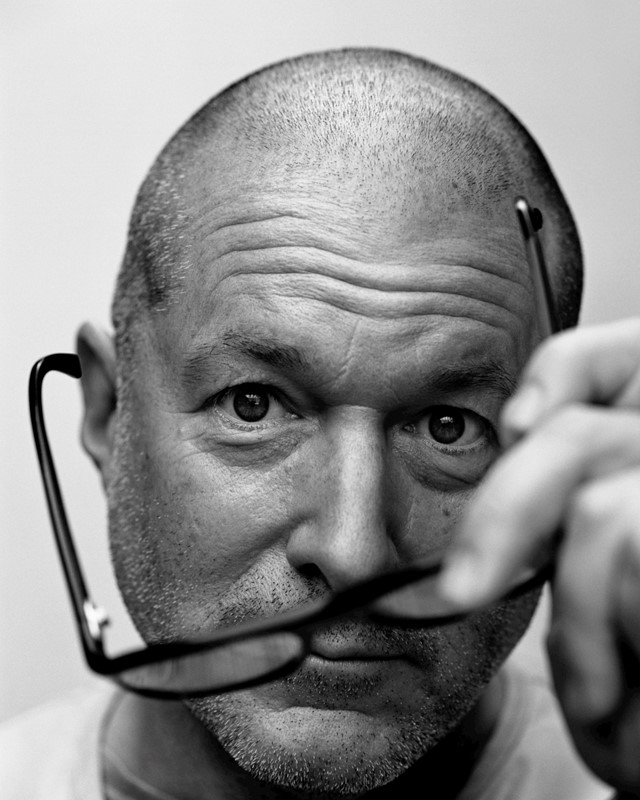The LoveFrom founder is launching a new scholarship programme to support aspiring designers in the US and UK
When Sir Jony Ive – the designer behind Apple’s most iconic products – left the company in 2019, he wasted no time in establishing his own creative collective: LoveFrom, which comprises a range of talented designers, architects, musicians, filmmakers, writers, engineers and artists. “I’ve believed for a very long time that gathering creatives together that have very different areas of expertise yields the most interesting work,” he says, speaking to me over Zoom from his home in San Francisco. “I was at Apple for nearly 30 years and was lucky enough to work very closely with Steve, but in my role as chief design officer, I also built a multidisciplinary team.”
“The LoveFrom team we’ve built is a much smaller one, but something the smaller size enables is really being able to focus on the process and the way we work together,” he continues. “One of the things I’ve always been fascinated by is the creative process and collaboration. Part of that is just as a result of being human, but it’s also a fascination that’s driven by trying to do the very best work.”
This fascination with fostering good creative work, is, in part, a driving force behind Ive’s latest venture: a new LoveFrom scholarship programme, designed to increase representation within the design community by encouraging and supporting young designers of colour. The scholarships will be awarded to undergraduate and postgraduate design students, and will cover tuition and some living expenses for design courses that reflect LoveFrom’s multidisciplinary creativity.
The scholarships are funded through endowments, long-term financial commitments to each college that provide permanent annual funding for each scholarship. One student is supported each year at California College of the Arts, one at Rhode Island School of Design, and up to two at the Royal College of Art in the UK. If you’re interested in applying, you can contact the college directly as part of the annual autumn admissions process.
We spoke to Ive about LoveFrom’s new scholarship programme, the barriers faced by young, aspiring designers, and the future of the design industry.
The new LoveFrom scholarship looks like a really great initiative. What inspired you to launch it?
Jony Ive: I’ve been involved in design education in lots of different ways for a long time; I have a role at the Royal College of Art, and that’s probably my most recent and ‘formal’ role. Another way of asking the question is just ‘why would you not?’. I have this preoccupation with trying to gather the very best people individually, but also being mindful of how they work together as a team, and I think [the scholarship] was really born out of that belief, and that passion I have.
I think there is also a frustration that the talent pool for underrepresented minorities is just far too small. In trying to do the scholarship programme well, we spoke to a lot of people with a lot of expertise. And we’re still learning, because this isn’t just a case of funding. It’s an important part of what we wanted to do, but we also wanted the LoveFrom scholars to be part of our collective, and part of our community. We realised that in ten years’ time, we’re going to have a community of 29 people who are LoveFrom scholars. I think that’s very exciting.
One of the things that I’ve really come to realise – and honestly it was probably precipitated by COVID – is just how important momentum is to the creative process. That sense of progress and progression that starts to become independent of your intention or your practice, that sense of being very aware that you’re part of something bigger, like some big tide that’s carrying you forward… it’s funny, in the last four or five years, I’ve placed more and more emphasis on how you develop and encourage and protect creative momentum. Momentum also helps you get through times when things can be creatively barren or difficult – what gets you through is partially your experience, and knowing that this season will come to an end and there are ideas waiting, but also what makes that much easier to endure is momentum.
The reason this comes to mind is because there’s just something about this idea that in ten years’ time there are going to be nearly 30 LoveFrom scholars – the momentum that could be part of that number is really powerful, I think.
“The danger of a very powerful tool, of course, is that it doesn’t necessarily push you to work hard on your thinking or your discipline” – Sir Jony Ive
It’s great that the scholarship is focused on getting people of colour into the design industry. What sort of barriers do people of colour face when trying to break in?
Jony Ive: One of the two issues that I’ve been most aware of is that design school and design education is expensive. I feel enormously fortunate that I got through high school, while there were still, for example, workshops in high schools. My father was also very involved in design education and promoting design as being part of the core curriculum, which sadly it no longer is. But by most measures, design education is expensive, whether it’s in the space it takes or the cost of facilities. I think that’s one of the most significant barriers, but then I also think part of it is a lack of clear examples of people of colour who have gone through the established design education system, and who are practising. There just aren’t enough examples. It’s self-perpetuating.
Part of it’s also just realising that design is an option. One of the things that’s always shocked me is that I hear so many people saying, ‘I didn’t know that this was a choice, I didn’t know what design was.’ There are bits of representation in certain disciplines – in graphic design, for example, there seems to be more representation – but for example, industrial design seems to be a discipline and practice that I think a lot of people don’t really even know exists.
You’ve just touched on this, but how do you think things have changed for young aspiring designers today, compared to when you first started designing?
Jony Ive: I’m going to be horribly Jony-centric for a moment... but when I went to Newcastle to study for four years, the tools that were available in terms of computer-aided design were only just becoming better understood. I was the last generation that really missed some of these tools, which were very sophisticated, that got you to what appeared to be compelling answers very quickly.
But the danger of a very powerful tool, of course, is that it doesn’t necessarily push you to work hard on your thinking or your discipline. I think in the UK there is more of an understanding or awareness of design – of course, if you ask people ‘what’s design’, you’re going to get 1,000 different answers because it’s a big word that means everything and nothing – but I think there’s slightly more understanding now about the creative activity. And the tools are extremely compelling and very powerful now – I think what concerns me is there is a danger that the rigour of the creative practice is overlooked, that we’re being seduced by making impressions quickly and by provocative imagery. Of course, it doesn’t mean those things preclude caring and worrying deeply, but it often does.
I’ve been reading a lot about AI recently, and whether it has creative capabilities. Do you think AI could potentially impact the future of the design industry?
Jony Ive: It will, without a doubt. Right now we’re in the middle of a raging debate – I don’t know whether you saw it, but there was a petition signed the other day calling for all the AI labs to pause for six months… I think the tools that we have are really defining. We define our tools, of course, but our tools also end up defining us and our culture and our society. As a creative, it’s very hard to create beyond the tools that you have, which is why very often I think creatives often end up taking time to develop the tools because of how important they are.
I think AI is a tool, the power of which I don’t think we’ve seen before. We certainly don’t comprehend the consequences and implications. But if you innovate, that’s something you have to become comfortable in – understanding that there will be consequences that you didn’t anticipate, some of them good and some of them not so good. And even though you didn’t anticipate them, I feel very strongly that you’re still responsible.
Finally, if you could give one bit of advice to aspiring young creatives, what would it be?
Jony Ive: Working hard and that sense of being patient. I think one of the greatest challenges we face is an expectation that things come quickly, because so much does nowadays. The creative journey is a wonderful and empowering and important journey, but it’s easier if you understand that if you’re going to do work of consequence, it will come at a cost. One of the big costs is time and working very hard with resolve and focus.




